CONTENTS:
A History of Margate Prints
The period to 1780
London publishers 1770-1860
Local publishers
Steel line-engraved vignettes, 1840-1875
Coloured prints
Late Victorian Leporello View Albums
Books and magazines
Ephemera
|
A History of Margate Prints
|
1. The period to 1780
Margate was not of sufficient interest to attract the attention of London print publishers until after its development as a major seaside resort in the 1780s.
|
The nearest we have to a print of Margate before this period is A view of the Pier of Meregate, a sketch map of Margate published in the second edition of Lewis’s The History and Antiquities as well Ecclesiastical as Civil, of the Ile of Tenet, in Kent published in 1736, showing the village of Margate built along the shore, leading up the hill to the parish and church of St. John the Baptist.
|
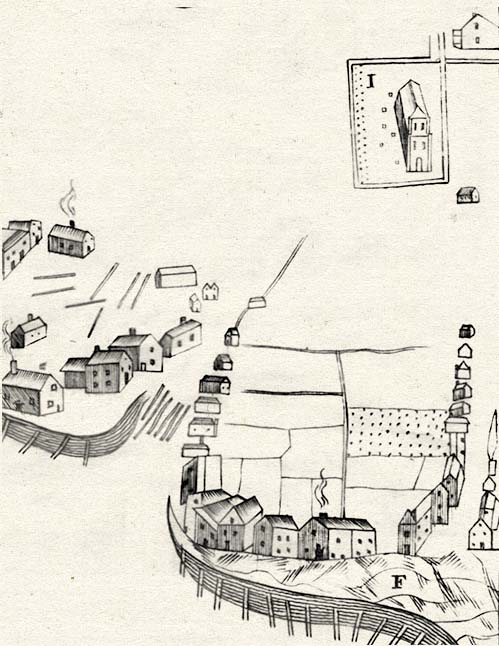
|
Apart from the church, there were no ancient buildings or large houses that would be of interest to collectors of topographical prints. What was of interest though, at least to visitors to Margate, were the newfangled bathing machines and The Margate Guide printed as a joint venture between T. Carnan and F. Newberry, of St Paul’s Churchyard, London, and J. Hall, High Street, Margate in 1775, included a picture of one.
|
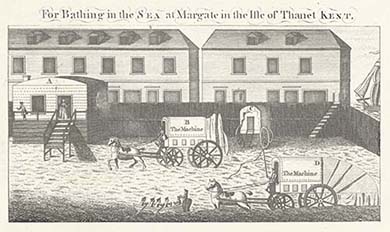
|
We see the simple bathing-room in which the bathers wait, a machine approaching the bathing room, and a machine actually being used for bathing. This is all explained very helpfully in an Appendix at the back of the Guide: ‘Explanation of the structure of the machine.
A. The Bathing-room, to the steps of which the machine B is driving, with its umbrella drawn up.
C. A back view of the machine, shewing its steps, and the folding doors which open into a bath of eight feet by thirteen feet, formed by the fall of the umbrella.
D. The machine, as used in bathing, with its umbrella down.
|
The proprietors of the various bathing machines were, of course, in competition and to attract customers they handed out advertising trade cards, actually just small flimsy sheets of paper.
|
A card published by James Mitchener promises: ‘At Margate in the Isle of Thanet, Kent, is Erected by James Mitchener. Commodious Machines for Bathing in the Sea. Where the Nobility, Gentry and others, who are pleased to Favour him may depend on all possible Care with a proper Guide for the ladies, & himself for the Gentlemen, & their favours thankfully acknowledg´d by Their most Obedient & humble Servant, James Mitchener.’
|
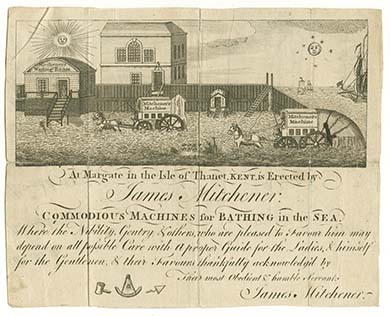
|
The card is undated, but in the Department of Prints and Drawings at the British Museum is an advertisement, printed at Canterbury in 1773, titled ‘Bathing at Margate, James Mitchener, begs leave to acquaint his friends and the public in general, that he, being obliged to remove from the Parade, has now a large and commodious waiting-room adjoining Hall's circulating library, ...’. This trade card was probably produced around the same period. It shows a view of Margate seafront including ‘Mitchener´s waiting room’, with horse-drawn bathing machines being pulled through the water, each titled ‘Mitchener´s machine’. Incorporated into the card are a number of masonic motifs which proclaim Mr. Mitchener´s credentials discreetly to other members.
|
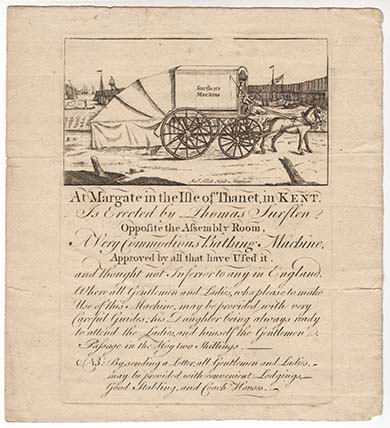
|
Thomas Surflen, another of the early Margate proprietors of bathing machines, issued a similar card:
‘At Margate in the Isle of Thanet in Kent is Erected by Thomas Surlfen Opposite the Assembly Room, A very Convenient Bathing Machine, Approved by all that have Used it…’
Surflen’s machine looks very much like that of Mitchener; the reference to the Assembly Room on the card refers not to the later Assembly Room erected in what became Cecil Square, but to John Mitchener’s New Inn and Assembly Room on the Parade.
|
A third card, for John and Mercy Sayer, former partners with Benjamin Beale, from the 1790s, again shows a very simple bathing room where the bathers would wait, very little different from that illustrated in the 1775 guide book.
|
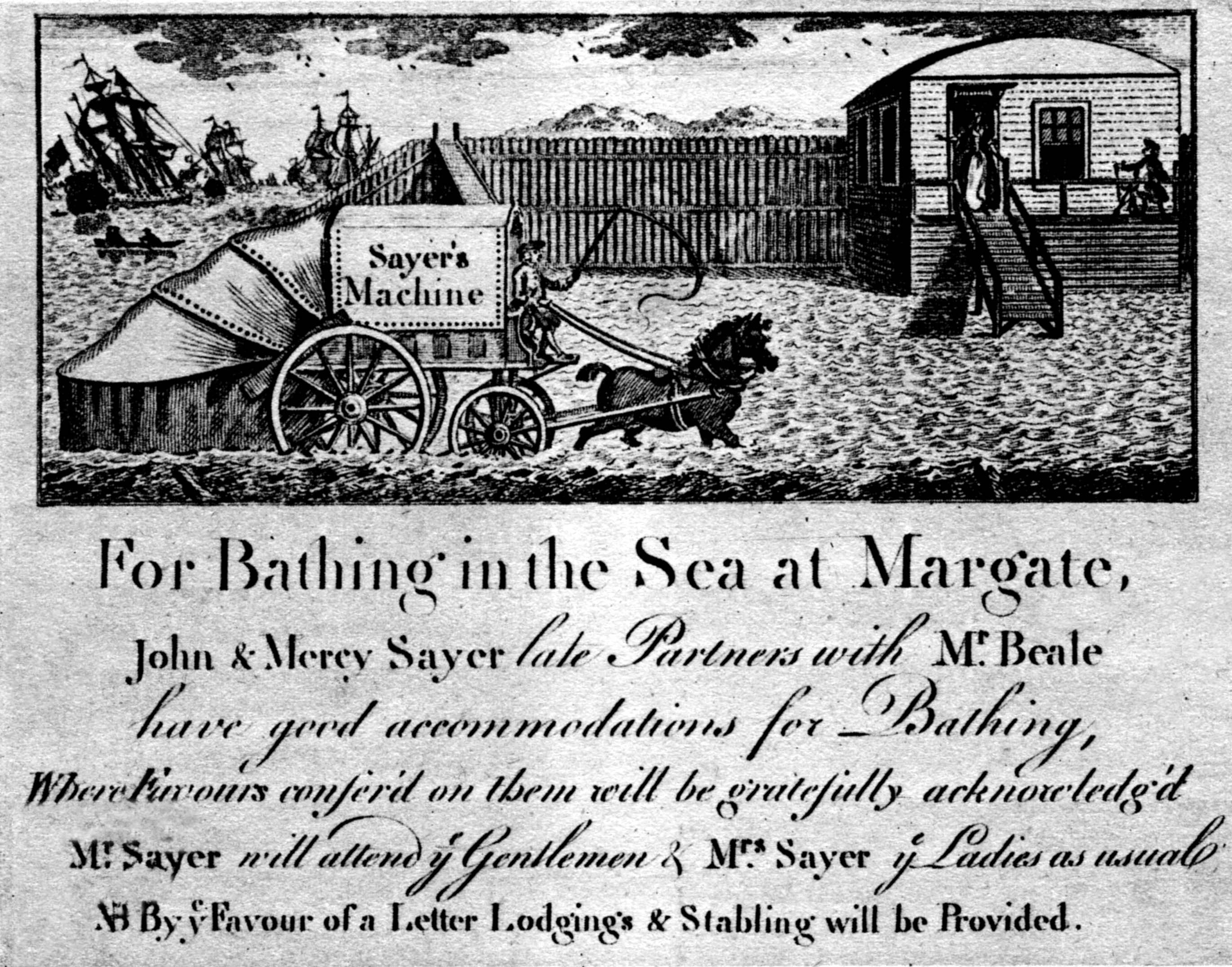
|
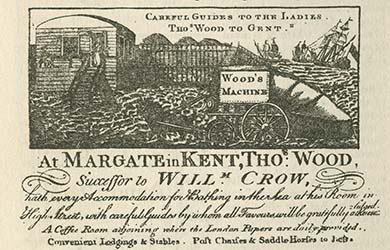
|
A fourth card was reproduced in the Home Counties Magazine for October, 1903. It bears no date, but presumably also belongs to the latter years of the eighteenth century. The upper part of the card contains a roughly drawn representation of a bathing-machine being drawn by a horse up the beach towards a bathing-house. On the side of the machine is inscribed in large letters " Wood's Machine," and on the space in the picture devoted to the sky is displayed the legend, "Careful Guides to the Ladies. Thos. Wood to Gentlemen."
|
Beneath the picture is the following advertisement:— " At Margate in Kent, Thomas Wood, Successor to William Crow, hath every Accommodation for Bathing in the Sea at his Room in High Street, with careful Guides by whom all Favours will be gratefully acknowledged. A Coffee Room adjoining where the London Papers are daily provided. Convenient Lodgings and Stables. Post Chaises and Saddle Hones to hire." It is easy to imagine the wood engravers annoyance as he came to the end of the fourth line and realised he had not left himself enough space for the word “acknowledged”.
Fortunately, Margate had developed sufficiently by the 1780s to become of interest to the London publishers, giving us a golden-age of prints that lasted until the trade was finally killed off by the photograph and postcard.
|
2. London publishers 1770-1860
The first Margate prints were not topographical prints but cartoons or caricatures.
Gatrell [Vic Gatrell, City of Laughter, Atlantic Books, London, 2006] has estimated that some 20,000 satirical and humorous prints were published in London between 1770 and 1830, when changing tastes rendered them near obsolete.
|
The first print to actually refer to Margate was probably The Margate Macaroni published in 1772. A perfect, well-travelled young Englishman of the 18th century who affected foreign customs and manners was called a "Macaroni" and Matthew Darly of the Strand, London published an album of caricatures in 1772, Macaronies, Characters, Caricatures &c designed by the greatest personages, artists &c. The etching of a Margate Macaroni shows an obese man with very short fat legs. In his right hand he holds an enormous cane which rests on the ground, in his left is a lorgnette (magnifying glass). He wears a looped macaroni club, a laced hat and coat, and a sword. Margate and other towns like Bath, the subject of another of the caricatures, already had the reputation of a rather plebeian watering place.
|
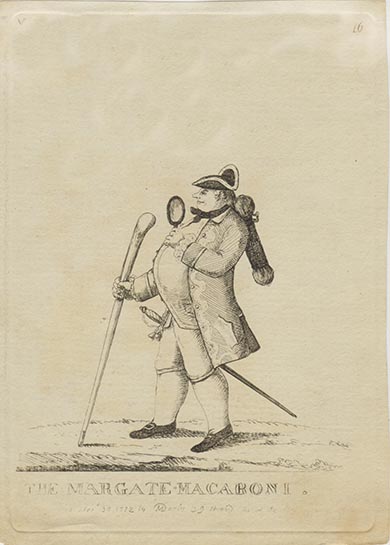
|
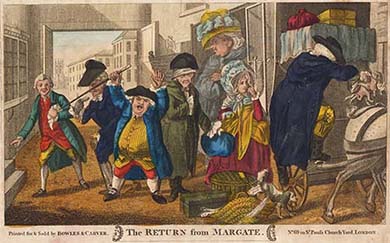
|
This idea of Margate as a rather plebeian holiday town was repeated in the hand-coloured etching The Return from Margate. Although the print shown here has had the bottom line trimmed off, an un-coloured version states ‘Publish’d as the Act directs, 25 Sept. 1782,’ establishing the date. The etching was printed for and sold by Bowles & Carver, of St. Paul’s Church yard, London. It shows a rather fat gentleman, losing his temper on returning to London with his family from a holiday in Margate. The label on a basket “Alderman Gattle” tells us that he is a London alderman, a typical London ‘cit’, a tradesman probably from the East End of town, who would holiday at Margate, trying to ape his betters, the real ‘people of consequence.’
|
The hand-coloured mezzotint The Barber Riding to Margate, also from 1782, and printed for and sold by Carington Bowles also of St. Pauls Church Yard, shows a man (on the right) outside a posting inn, fashionably dressed in riding clothes but unable to control his horse, which has been startled by the drum and fifes of a recruiting party in Guards’ uniform. Falling out of the riders’ pocket is a pair of curling tongs and a box which he was carrying has fallen to the ground, where various articles of the barber's trade have spilt out: tresses of hair, a packet of "Powder", a comb, razor, etc. The message is that this kind of disaster will always show up someone trying to ape the behaviour of their betters.
|
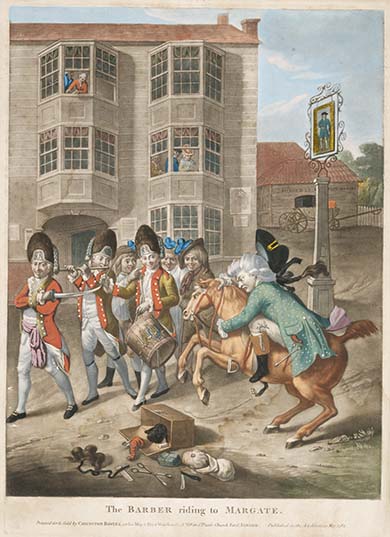
|
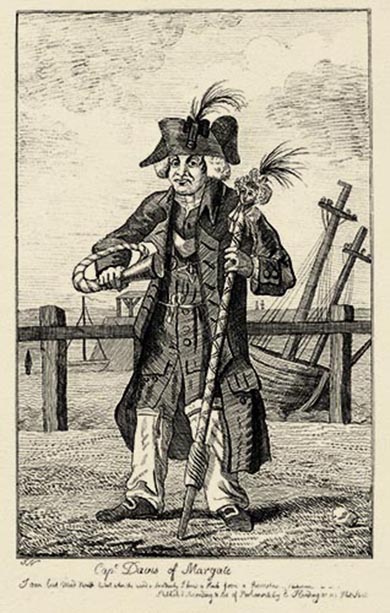
|
Rather different is another early engraving, this time of an odd Margate character, Captain Davis, published by E. Harding of Fleet Street, London. Although the print is undated, it was probably published in the early 1780s since Davis died in 1788 [Kentish Gazette January 18, 1788]. Under the print is a misquotation from Hamlet, reading in the original, "I am but mad north-northwest: when the wind is southerly / I know a hawk from a handsaw". Whether the misquotation was deliberate or a mistake is unknown, at least to me. Reporting Davis’s death, the Kentish Gazette said ‘A few days since died in a hay-loft at Margate the person who has long wandered in an insane state in various parts of this county, by the name of Captain Davis. He went to rest at night apparently in health, but not being seen at his usual hour in the morning, and searching the place where he had slept for some time past, he was found quite dead. Eleven guineas, it is said, were in his pocket.’
|
Another source of amusement to the print maker was the horror of a voyage to Margate by the Hoy, one of the most popular methods of getting from London to Margate in the eighteenth and early nineteenth centuries, at least for the less wealthy.
|
The Margate Hoy, a hand-coloured etching by Charles Catton (1750-1819), a scenic painter and producer of etchings, was published by William Hinton of Sweetings Alley, Royal Exchange, London in 1785. It shows the stern of one of the hoys from London to Margate, with passengers suffering from the effects of a fresh breeze. The passengers on deck make plentiful use of buckets; one ‘lady’ has turned to the bottle, probably of gin, for comfort. We glimpse two of the passengers below decks, who are suffering at least as much as those on deck.
|
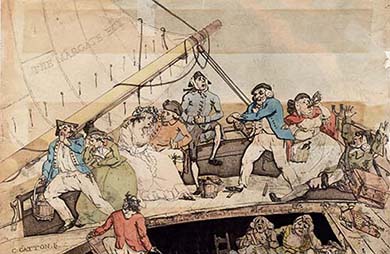
|
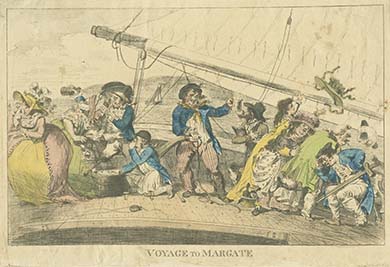
|
The Voyage to Margate, another hand-coloured etching published by William Hinton in 1786, this time by Isaac Cruikshank, has a similar message. The steersman, leaning against the tiller, holds up a mug of frothing beer. The eight passengers are in various stages of distress and sea-sickness, except for a naval officer with a wooden leg who holds his wife's forehead and pours the contents of a bottle on her head; a sailor boy proffers a bucket to this couple. A man's hat and wig blow overboard, as does a young woman's large hat.
|
The first topographical print of Margate appears to be a mezzotint published in 1785 by Simon Watts of London, A View of Margate Pier and the Two Sisters; the “Two Sisters” refers to the twin towers of Reculver church visible in the background of the print. The print is based on an original watercolour titled Margate Pier taken from the Cliffs painted by John Nixon in 1783. John Nixon (c1755- 1818) was the son of an Irish merchant based in London and travelled extensively, including trips to watering places such as Bath and Margate. On his travels he produced many watercolour pictures; between 1781 and 1815 he exhibited 39 paintings as an honorary exhibitor at the Royal Academy. The print shows a prosperous looking gentleman going for his walk along the beach, while behind him two workers collect sea-weed. Three bathing machines can be seen in the sea.
|
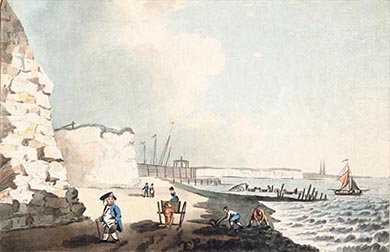
|
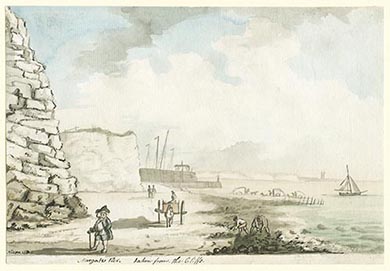
|
A View of Margate with the Bathing Place, an aquatint published by J. Wells of Charing Cross from a drawing by T. Smith in 1786 gives us the first detailed view of the bathing rooms along the High Street. These look to be rather rickety structures with steep flights of stairs leading down to the beach where several bathing machines wait to pick up bathers.
|
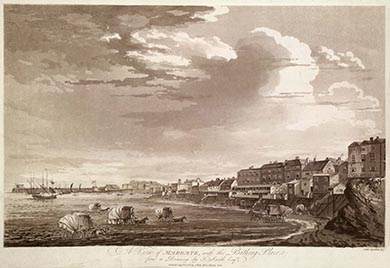
|
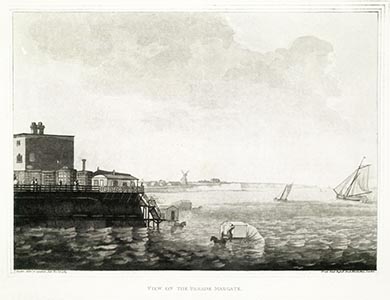
|
A View of The Parade, an aquatint published by J. Saunders of Great Russell Street, London in 1789 shows the bottom of the High Street with James Mitchener’s Library and a building looking rather like a simple wooden shack, the waiting room, again with a steep flight of stairs leading down to the sands. Mitchener’s trade card described above show only a single short flight of stairs, presumably because at high tide, as shown on the card, the sea came up and covered the bottom part of the stairs.
|
Also in 1789 was published a hand-coloured engraving of Halls Library at Margate, after a drawing by Georgiana Keate. This shows the extent to which the libraries in Margate and other holiday towns were shops and meeting places as much as lending libraries. Zachariah Cozens described the library as follows in A Tour through the Isle of Thanet, and some other Parts of Kent, published in 1793:
‘Hall's elegant shop and library [is] much the largest of any in the town, and finished in an expensive manner: it consists of two compartments; the first containing a curious assortment of jewellery, toys, Tunbridge Wares, muslins, etc.... A row of handsome columns ... separates the shop from the library, composed of a well chosen collection of amusing books, in various languages ... [While] the building is pleasing to the cursory inspector, [it] would have given more pleasure to the informed architect, if the builder had confined himself to a strict observance of the Orders; as such a departure from them, as is observable in almost all our modern buildings, will be a proof of the declining taste of this extolled age.’
Following these earliest prints, numerous engravings, aquatints and lithographs, as well as caricatures, of Margate were produced by the London publishers, further examples of which will be listed here.
|
3. Local publishers
Competing with the London publishers were a number of local publishers, initially all proprietors of the local libraries where a wide range of nick-knacks were sold to the visiting public. Many of these prints may have been rather unsophisticated, but that does not make them any less interesting or informative
|
One of the first of the local publishers was P. Burgess, of the Library at Ramsgate who published an undated coloured engraving simply called Margate, showing the Parade and bottom part of the High Street.
|
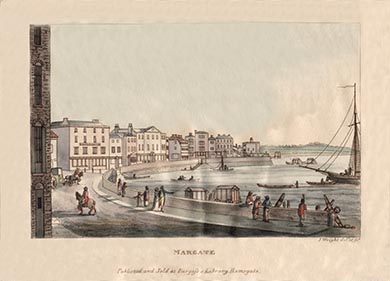
|
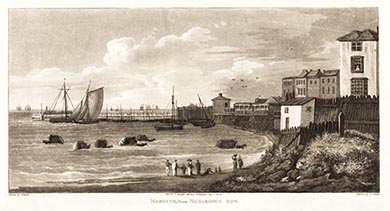
|
He published a further aquatint of Margate, Margate, from Hazardous Row, in 1809, from a drawing by J. Laport, engraved by J. C. Stadler, showing the rickety balconies of the waiting rooms, crowded with bathers looking out to sea while they wait.
|
An 1802 aquatint of Margate (from near the Mill) Westbrook, was published by Warren, on the Parade.
|
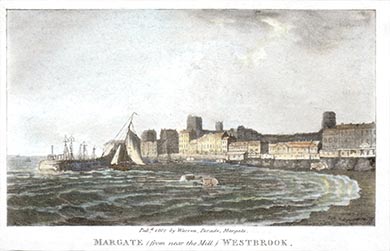
|
Two undated prints from stone, Margate Pier and View of Margate taken from The Harbour, were published by father and son, S. Bettison of Hawley Square, and W. G. Bettison of High Street, and printed by W. Cole of Newgate Street, London.
|
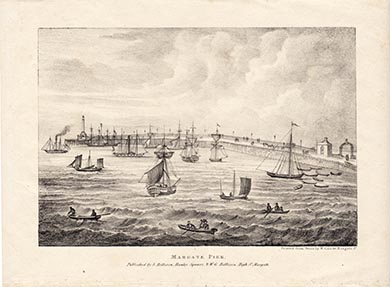
Margate Pier
|

View of Margate from the Harbour
|
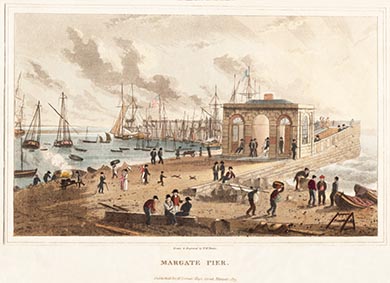
|
A hand-coloured aquatint, Margate Pier, drawn and engraved by W. H. Timms, was published in 1819 by W. Garner, at his High Street library.
William Henry Timms was born in Reading in about 1791 and married a Margate girl called Sarah sometime before 1818. He lived in London until about 1828, but his last four children were born in Margate (between 1827 and 1835) and he is listed in Pigot’s directory for 1832-4 at 9 High Street Margate, as an engraver and landscape painter. [Information courtesy of Katie Amos]
|
A hand-coloured aquatint, Marine Terrace, Margate, was published by another of the Margate librarians, J. Denne, at Queen Street, but printed by Barnett and Son, probably in London. This print makes an interesting comparison with the much larger aquatint published by Bettison of the same scene.
|
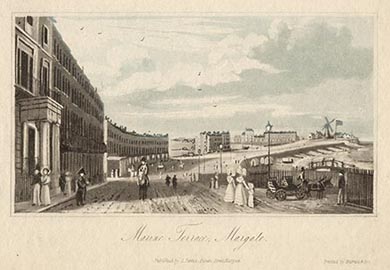
|
Although not strictly prints, printed images of Margate were also produced to be attached to all kinds of souvenirs to be sold in the libraries and shops of Margate.
|
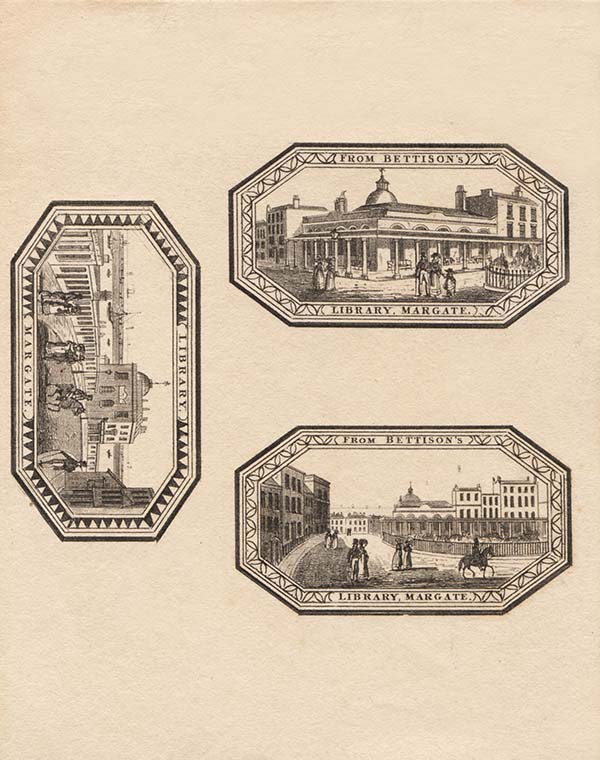
|
A sheet shown here contains three views of Margate, with the text around the border reading “From Bettison’s Library, Margate”, each illustration being just 1 ¼ inches by 2 ¼ inches.
|
Even smaller are the six illustrations, each just 1 inch by 1½ inches, on this sheet, with pictures of “Iron Bridge, Margate”, “Margate from the Jetty”, “The Parade & Fort Crescent”, “The New Landing Place & Pier”, “Royal Crescent” and “Margate & Sands”. Although the publisher is unknown, they presumably were destined to be stuck on small ‘Presents from Margate’.
|
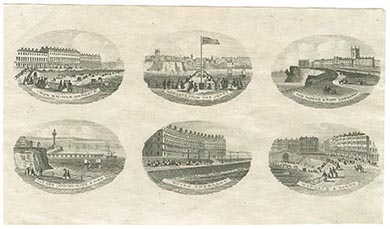
|
Most interesting are the set of prints published at Wises Manufactory, Tunbridge Town for use on their Tunbridge Ware boxes.
|
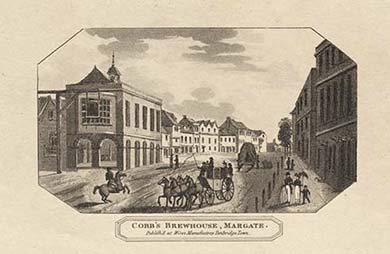
|
The picture shown here is of Cobb’s Brewhouse and the image is 3 ¾ inches by 2 ¼ inches. Typically the image would be pasted to the outside of the box without the legend, the legend being cut off and pasted inside the lid. Nine such prints of Margate are listed in Austen’s book on Tunbridge Ware as having been identified on Tunbridge ware pieces, with many more serving just as separate prints [Brian Austen, Tunbridge Ware and Related European Decorative Woodwares, Foulsham, London, 2001].
|
The prints of Margate date from about 1806. The production of Tunbridge ware continued until the outbreak of World War II, but from the 1820s was in competition with the much cheaper transfer-printed or Mauchline ware. The design for a Mauchline ware piece was printed from an engraved plate onto special Japanese paper. This was then varnished on its face, placed down onto the freshly shellaced surface of the item to be decorated, and left to dry. After drying the paper was removed with a damp cloth, leaving the ink impression behind. A wide variety of Mauchline ware items decorated with views of Margate can be found, including boxes for toilet and writing tables, work boxes, sewing aids such as cases for bodkins, crochet hooks and knitting needles, and novelty tape measures, holders for balls of wool, and similar items.
|
4. Steel line-engraved vignettes, 1840-1875
In the second half of the 19th century the print scene was dominated by the small-scale steel line-engraved vignette. These were produced in large numbers, mostly by London printers, and catered for the cheaper end of the tourist market.
|
The earliest major publisher in this field was J. Harwood of London who between 1841 and 1854 published well over one thousand views in his numbered series Scenery of Great Britain, at least five of which are of Margate; there probably are more. That shown here is a print of the Marine Terrace.
|
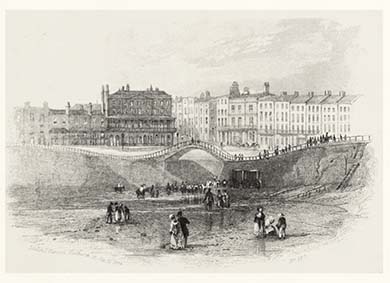
|

|
Another early publisher of vignettes was Kershaw and Son, publishing many vignettes in the period between about 1845 and 1860, such as the bound volume Twenty Four Views of Margate, selling for 1 shilling, equivalent to about £3 today.
|
The most successful national publisher in this field was William Frederick Rock (1801-1890). As well as books of prints containing from 6 up to 30 prints, he also published fancy stationery and cards, such as the letter paper shown here.
|
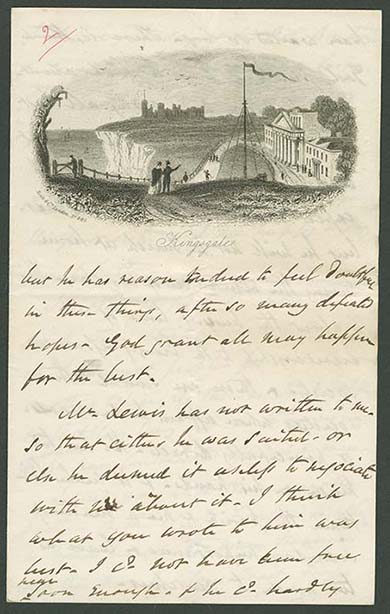
|
A later publisher was John Newman and Co. Their prints of Margate date to between 1871 and 1880 and are of lower quality than those published earlier.
A few vignettes were also published by the Margate libraries.
|
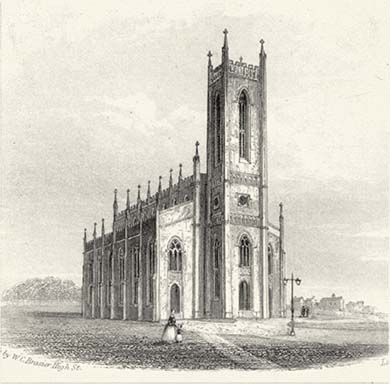 |
W. C. Brasier, of the High Street, published a vignette of Trinity Church
|
Robert Chappell Osborne, a bookseller and printer in the High Street in the 1830s published a rather nice vignette of the Landing Place, Droit House and Pier Office.
|
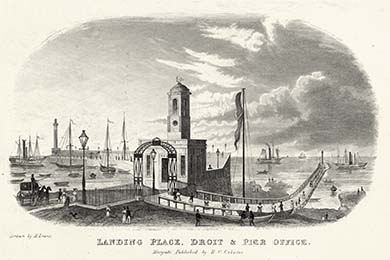 |
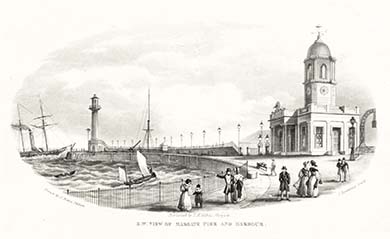 |
T. H. Keeble published a vignette S.W. View of Margate Pier and Harbour.
|
Probably the most prolific local publisher of this kind of print was William Perry. William Perry is listed as a drawing master, living at 1 ½ Broad Street, in the Post Office Directory for Kent of 1851 and as a Bookseller and Stationer at 4 Broad Street in the Post Office Directory for Kent of 1855.
|
His Twelve Views in Margate contain views of Margate drawn and published by himself, probably in the 1850s. Six were published as coloured prints in his Coloured Views in Margate, as described below, where the prints are dated between 1853 and 1858.
|
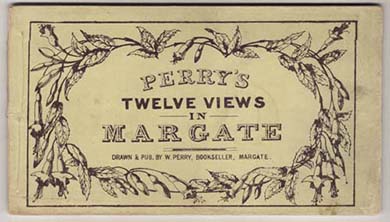
|
I am sure there must also be other locally published vignettes that I have not seen.
|
5. Coloured Prints
Many of the aquatints and lithographs described above were available in both uncoloured and in hand coloured states.
|
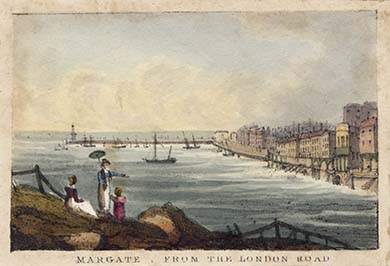
|
In the 1820s the firm of Hodgson and Co., of 16 Newgate Street, London, produced their ‘Picturesque Views’ of towns such Brighton, Tunbridge Wells and Margate, under the generic title of Polygraphs. Polygraphs were probably hand-coloured lithographs, but this is not certain. They can be found both with borders and titles, as shown here for the print Margate from the London Road, and trimmed to the image. The views of Margate date from the period 1825-28, as they show the ornamental arch leading to the Jetty (built in 1825) and the old Droit House, work starting on a new larger structure in 1828.
|
A book of rather poorly coloured prints of Margate was ‘drawn and published’ by William Perry, Bookseller and Stationer at 4 Broad Street, Margate, under the title Perry’s Coloured Views in Margate. These prints are coloured versions of some of the engravings published as Perry’s Twelve Views in Margate and date from the late 1850s. The print shown here is the print of Fort Crescent and Paragon, dated June 2nd, 1855.
|
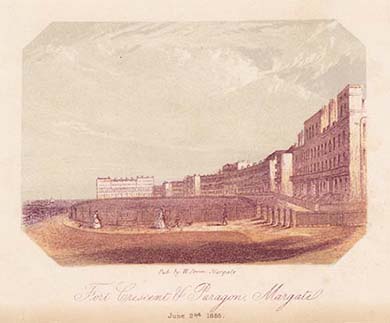
|

|
A book of chemolithographs, Views of Margate and Ramsgate, was published by T. Nelson and Sons, London, at 1 shilling, and contained a set of very attractive prints. The illustrations were drawn by a Mr W. H. Prior. The book was advertised for sale in 1867 (Bamber Gascoigne, 'Milestones in Colour Printing 1457-1859', CUP, 1997)
|
6. Late Victorian Leporello View Albums
Books of steel line-engraved vignettes had disappeared by about 1880, at which time real photographs were still relatively expensive and the picture postcard had not yet arrived .This left a gap in the market which was filled by the rather unsatisfactory sepia-tinted ‘photo-lithographs’, printed on coated paper and largely produced in Lower Saxony, Germany. These photo-lithographs usually have an essentially photographic base to which has been added hand-working, giving a picture with the appearance of both a photograph and a drawing. The process of ‘photo-lithography’ (with a hyphen) should not be confused with ‘photolithography’ (without a hyphen), the lithographic process in which plate images are produced photographically, and is the basis of modern picture publishing. Maurice Rickards and Michael Twyman in The encyclopedia of Ephemera describe the process of photo-lithography as follows: “In the photo-lithographic view a monochrome image is separated into five or six basic tones, each contributing to the multi-tone effect of the reconstructed picture. As with chromolithography, hatching, stipple, and other effects were used to produce tonal gradation. In chromolithography the whole of the work was carried out by hand; in the present process the original photograph was printed as a ‘ghost image’ on five or six separate stones, each image then being worked over manually according to its tonal role in the final reproduction.”
Photo-lithographs were generally published in albums containing a single long page, printed on just one side, folded concertina-fashion and contained within ornate gilded card covers. They are referred to as Leporello Albums, Leporello being the term used in the German music publishing business for a folded single sheet. Most albums date from about 1880 and extend through to 1900, when they were replaced by the cheaper picture postcard.
One company producing albums of this type was Rock and Co. Their Queen’s Album of Margate contained 12 views based on their books of steel line-engraved vignettes, with dates under the prints that presumably referring to the dates of the original engravings, including two illustrations of the elaborate “Aquarium and Marine Polytecnic” that was never actually built.
|

A section of Rock's The Queen's Album of Margate
|
More typical were the various versions of The Album of Margate Views published by Charles Reynolds and Co. These were undated, but probably correspond to the 1890s. Despite their odd nature, many of the views are of interest, such as this one of the Zoological Gardens at Margate.
|
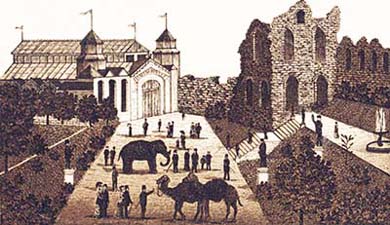 |
7. Books and Magazines
Engravings on cooper and steel were used to illustrate guide books and histories of the County of Kent, separate plates being bound into the book
|
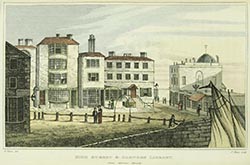
|
A good example is the Picture of Margate and Its Vicinity by W. C. Oulton, published by Baldwin, Cradock, and Joy, London, in 1820 at 9 shillings [New Monthly Magazine May 1820, p 605]. This contains many important prints of early Margate
|
Another example is England’s Topographer, or, A New and Complete History of the County of Kent by W. H. Ireland published by Geo Virtue, London, in 1828, containing a number of plates of Margate drawn by George Shepherd. Plates from these books were probably sold separately and many single prints can be bought today, often with recent hand colouring, as in the example shown here.
|
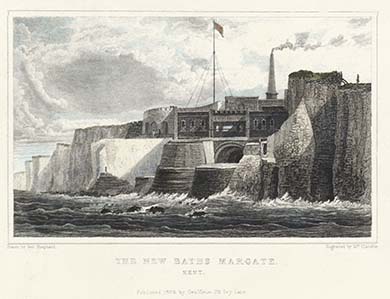
|
Wood block engravings were also used to illustrate books and magazines, these usually being printed as part of the normal printed page. As a consequence they are not counted as ‘real’ prints by collectors. Nevertheless, as non-photographic printed images it is convenient to list them here.
|
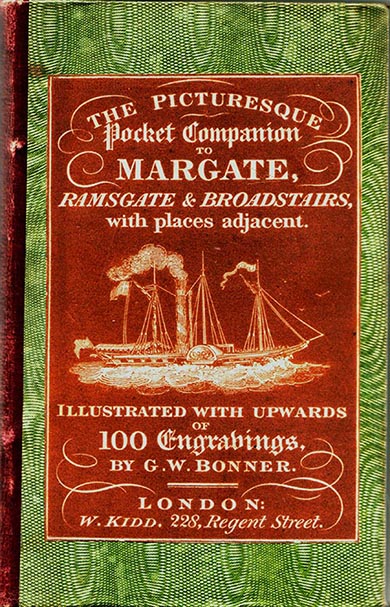
|
A particularly interesting book is Kidd’s Picturesque Pocket Companion to Margate, Ramsgate and Broadstairs and The Parts Adjacent…Illustrated with upwards of 100 Engravings by G. W. Bonner, published by William Kidd in London in 1831. The prints used to illustrate the header for this web page were taken from Kidd's book
|
Wood block engravings were also used to illustrated periodicals such as the Illustrated London News and The Builder up until about 1880 after which lithography took over. Shown here is a picture of the Sailor's Observatory, for a long time a landmark of Margate on the Fort, taken from the Illustrated London News for 30th Septpember, 1865. The building was described as follows: "The interior comprises a large reading-room, a small parlour and coffee-room, a convenient dwelling-house for the superintendent, and an observatory commanding both the Goodwin and the Margate Sands. The work was executed by Messrs. Jenkins and Smith, of Margate, and the coat of the whole will be about £650."
|
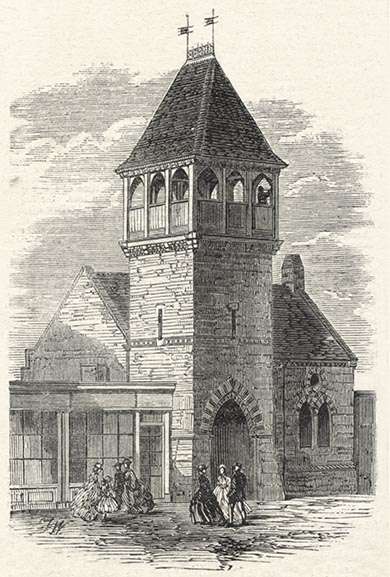
|
8. Ephemera
Ephemeral printed material such as the advertisements for bathing rooms described above can provide useful illustrations of early Margate, but such material rarely survives.
|
|
[END]
|
|
top of page
|




